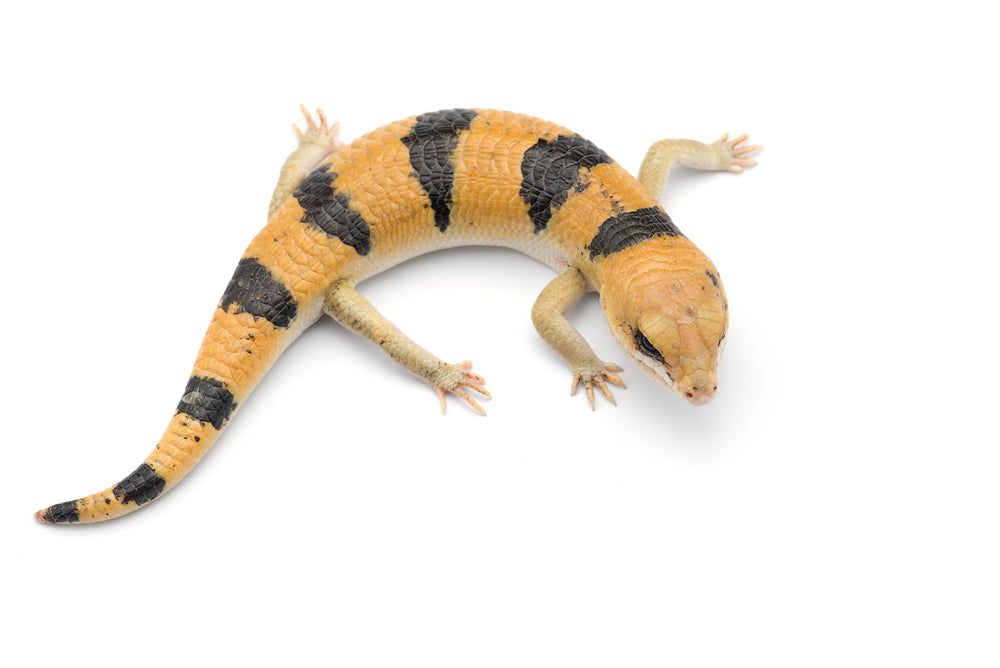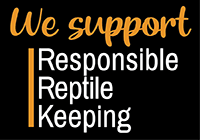Peters Banded Skink Care Guide (Scincopus fasciatus)

Peters’ banded skinks are medium-sized, fossorial lizards native to the northern and southern borders of the Sahara Desert in Africa. These areas are arid to semi-arid and may feature diffuse desert vegetation, savanna, scrub, and/or stony terrain. The soil is typically sandy and loose. They are primarily active at night, which time is spent mostly hunting for insects.
An adult Peters’ banded skink measures 5-7” long from snout to tail, with a robust tapered body, large scales, short tail, and short toes. The pattern is yellow-orange with a pale belly, broad black banding, black eyes, and smoky black markings around the eyes.
Peters’ banded skinks are essentially entirely wild-caught in the pet trade, and relatively little is known about their natural history. In the right hands, however, they can make rewarding pets.
What You Need for a Bioactive Peters’ Banded Skink Enclosure
- 36”L x 18”W x 18”H front-opening enclosure
- Exo Terra Reptile Glow Light, small, x2
- 50w Arcadia Halogen Heat Lamp, x1
- 50w Arcadia Deep Heat Projector, x1
- Bio Dude Digital Thermometer / Hygrometer, x2
- Plug-in lamp dimmers, x2
- 22” Arcadia T5 HO Forest 6% UVB Bulb
- The Bio Dude Solar Grow T5 HO Single Bulb Light Strip, 24"
- The Bio Dude Glow & Grow LED, 22”
- Zilla 24/7 Digital Timer Power Center
- Terra Sahara Bioactive Kit, 40 gallon
- Leopard Gecko Clean-Up Crew Pack
- Desert plants
- Environmental enrichment items (caves, hollow logs, sturdy branches, etc.)
- Food and water bowls
- Repashy Calcium Plus supplement
- Zoo Med Stainless Steel 10" Curved Feeding Tongs
Terrarium Size
Your new pet should be housed in nothing smaller than a 40-gallon “breeder” enclosure, with at least a 4” substrate dam for the substrate. If you can afford larger, then it’s strongly advised to do so. When the space is properly utilized, bigger is always better. For maximum convenience and less risk of frightening your skink, get an enclosure that opens from the front rather than from the top. PVC or wood enclosures with opaque walls are particularly good for helping your pet feel secure.
Given enough room, Peters’ banded skinks can usually be safely housed in groups. This is not required for their mental well-being, and they can be perfectly happy on their own, but a 40-gallon enclosure can adequately house up to 2 skinks. Males and females should only be housed together for breeding purposes, and males should never be housed with other males. If you don’t know the sex of your skink, it’s best to keep them solitary.
Lighting
Peters’ banded skinks are nocturnal, which means that they are primarily active at night. This means that they can survive without exposure to UVB radiation, but doesn’t necessarily mean they don’t benefit from it. In fact, current research indicates that nocturnal reptiles are likely to benefit when it is provided! Reptiles use UVB light to create the vitamin D that their body needs, as well as to strengthen their immune system and stimulate the production of endorphins. UVB even helps keep the enclosure free of pathogens, which is especially important for bioactive setups since you’re not going to be routinely disinfecting it or replacing the substrate.
The Arcadia T5 HO Forest 6% or Zoo Med T5 HO Reptisun 5.0 UVB bulb is likely to work best for Peters banded skinks, installed in a highly-reflective T5 HO fixture. The lamp should be placed on the same side as the heat sources, and the basking platform should be 9-11” below the lamp when the lamp is placed over a mesh top. This is because the intensity of a UVB bulb’s output changes with distance. Your UVB bulb must be replaced every 12 months to maintain its output. Resist the temptation to use other brands — when it comes to UVB, brand matters!
Because this is a bioactive setup, you will also need a plant light to encourage healthy plant growth. We recommend the Bio Dude Glow & Grow LED for this purpose. The light should span 75-100% of the enclosure’s length. This is not optional if you want healthy, thriving plants!
Lights should be cycled seasonally from 13 hours/day during summer and 11 hours/day during winter. Alternatively, you can use a smart timer to effortlessly sync your lights with your local sunrise/sunset times!
Heating
Like other reptiles, Peters’ banded skinks are poikilothermic, which means that they need a range of temperatures within their enclosure so they can regulate their own body temperature as needed. Areas of heat speed up their metabolism and promote activities like digestion and healing. Cool areas slow the metabolism and promote activities like rest and energy conservation.
Peters’ banded skink temperature gradient:
- Basking: 95-100°F
- Ambient (air): 85°F
- Nighttime: 75-80°F
To create a basking area for your skink, you will need a halogen flood heat bulbs like the 50w Arcadia Halogen Heat Lamp (optimum wattage may vary) and a ~5.5” dome lamp fixture like the Exo Terra Reptile Glow Light. Place a large piece of aquarium slate, sandstone, or flagstone on top of the substrate directly under the heat lamp to absorb heat and create a warm area for the skink to burrow under as desired.
You will likely require additional equipment to provide enough heat at night to meet a Peters’ banded skink’s preferred temperatures. Do not keep your heat lamp on at night, as it’s highly unnatural for light to be present 24/7, and it will mess with your skink’s ability to tell between day and night. Instead, use a lightless heat source like the 50w Arcadia Deep Heat Projector and plugged into a lamp dimmer to dial down to maintain a warm side night temp of 78-80°F.
To monitor your temperature gradient, place a digital probe thermometer like the Bio Dude Digital Thermometer / Hygrometer in the basking area, and then put another one on the cool side.
Humidity
Peters’ banded skinks are arid to semi-arid lizards, so you’ll want to keep ambient humidity levels low with plenty of ventilation and provide free access to a moist/humid retreat of some kind for use as desired. You shouldn’t have to worry about exact levels too much as long as you’re using an enclosure with a mesh top, a sufficiently warm basking area, and a deep, well-draining substrate. Add water to a patch of the substrate on the cool side of the enclosure (preferably under a piece of bark or stone) 1x/a week to create a moist retreat.
Pay attention to the water needs of the plants that you choose to use in your enclosure, and water them as needed.
Substrate
A thick layer of bioactive-compatible substrate is essential to creating a bioactive Peters’ banded skink enclosure. This layer of the substrate should be at least 4” deep (preferably deeper if you can, since this provides more room for your plants’ roots).
Because Peters’ banded skinks require a relatively dry environment, no drainage layer is needed. Instead, you can jump right to the dirt. You will need a soil-like mix that mimics a desert habitat and nurtures desert-type plants. If you want to make your bioactive mix, you will need a mixture of 60% organic topsoil and 40% play sand (measured by volume), then mixed with leaf litter, sphagnum moss, and 1 dose of 36qt Bio Shot to inoculate your soil with beneficial microfauna.
Alternatively, you can let The Bio Dude do the work for you with The Bio Dude’s Terra Sahara bioactive substrate kit. Either way, make sure there’s some wood and biodegradables on top for the CUC.
To make the substrate fully functional, make sure to add CUC organisms like powder orange/blue isopods, and arid springtails. You can also add other species like death-feigning beetles, mealworms, and super worms!
Decorating the Enclosure
Enclosure décor is about more than just making your setup look good. It’s also an important part of providing environmental enrichment to your lizard, which enhances your pet’s quality of life by providing opportunities to express natural behaviors. Although your Peters’ banded skink may not seem particularly active to your perception, they’re usually quite busy at night. Use things like low branches, cork flats/hollows, caves, and plants for your skink to explore and hide in.
Live plants in particular are critical to helping your mini-ecosystem function properly. Make sure the plants that you choose are drought-tolerant. Drought- and heat-tolerant succulents like aloe, haworthia, echeveria, and crassula will help prevent the enclosure from getting too wet.
It’s also good practice to cover 3 sides of the enclosure, which helps your skink feel less exposed and decreases stress.
Feeding Your Peters’ Banded Skinks
Peters’ banded skinks are insectivores, which means that they need to eat mostly insects in order to be healthy. Offer however much they can eat in about 5 minutes. Juveniles should be fed daily, and young adults fed every 2-3 days.
Make sure to feed your skink as large of a variety of foods as possible:
- crickets
- dubia roaches
- discoid roaches
- black soldier fly larvae
- mealworms
- mealworm beetles
- superworms
- small hornworms
- silkworms
- Repashy Grub Pie gel diet
Feeder insects should be no larger than your skink’s head (with the exception of soft-bodied hornworms and silkworms). ALL FEEDER INSECTS SHOULD BE LIGHTLY DUSTED WITH CALCIUM SUPPLEMENTS BEFORE FEEDING.
As a treat, a little bit of chopped fruit can be offered no more than 1x/week. Appropriate fruits may be berries, cactus fruit, apples, pears, banana, papaya, and mango.
Calcium & Vitamins
To ensure that your pet is getting all the vitamins and minerals they need, you need a calcium powder and a multivitamin powder. Take care not to use these too often; too much vitamins can be just as deadly as too little. Repashy Calcium Plus is a good way to provide a safe dose of each at the same time.
Water
Your skink should always have access to fresh, clean drinking water. Choose a small bowl that is shallow enough to prevent drowning. Change the water daily to keep it fresh, and scrub the bowl with a veterinary disinfectant at least once a week.
Handling Tips
Peters’ banded skinks are generally not the most handleable pet, although each animal is its own individual, and some may be more tolerant of humans than others. If you want to try bonding with your skink, try tong-feeding first. With time and patience, your pet may become accustomed to you enough to allow gentle handling.
Care information courtesy of ReptiFiles.
- Tags: Bioactive terrarium Heating
- Rebekah Walenta










